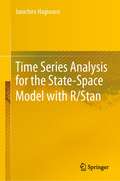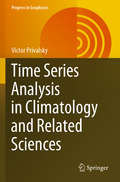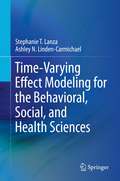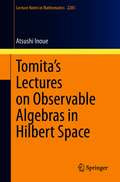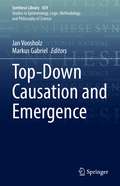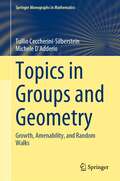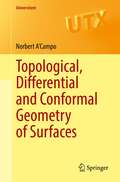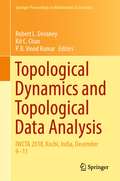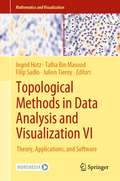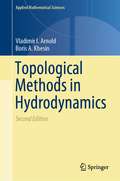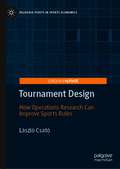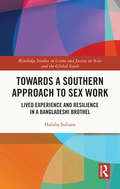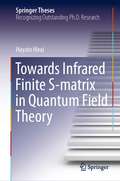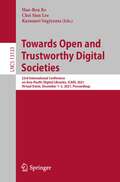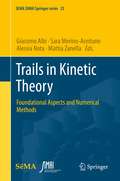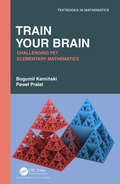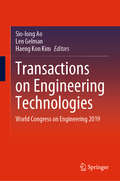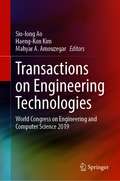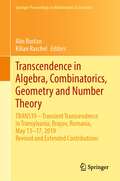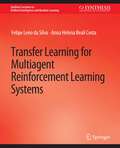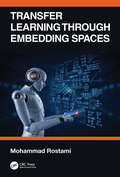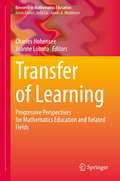- Table View
- List View
Time Series Analysis for the State-Space Model with R/Stan
by Junichiro HagiwaraThis book provides a comprehensive and concrete illustration of time series analysis focusing on the state-space model, which has recently attracted increasing attention in a broad range of fields. The major feature of the book lies in its consistent Bayesian treatment regarding whole combinations of batch and sequential solutions for linear Gaussian and general state-space models: MCMC and Kalman/particle filter. The reader is given insight on flexible modeling in modern time series analysis. The main topics of the book deal with the state-space model, covering extensively, from introductory and exploratory methods to the latest advanced topics such as real-time structural change detection. Additionally, a practical exercise using R/Stan based on real data promotes understanding and enhances the reader’s analytical capability.
Time Series Analysis in Climatology and Related Sciences (Progress in Geophysics)
by Victor PrivalskyThis book gives the reader the basic knowledge of the theory of random processes necessary for applying to study climatic time series. It contains many examples in different areas of time series analysis such as autoregressive modelling and spectral analysis, linear extrapolation, simulation, causality, relations between scalar components of multivariate time series, and reconstructions of climate data. As an important feature, the book contains many practical examples and recommendations about how to deal and how not to deal with applied problems of time series analysis in climatology or any other science where the time series are short.
Time-Varying Effect Modeling for the Behavioral, Social, and Health Sciences
by Stephanie T. Lanza Ashley N. Linden-CarmichaelThis book is the first to introduce applied behavioral, social, and health sciences researchers to a new analytic method, the time-varying effect model (TVEM). It details how TVEM may be used to advance research on developmental and dynamic processes by examining how associations between variables change across time. The book describes how TVEM is a direct and intuitive extension of standard linear regression; whereas standard linear regression coefficients are static estimates that do not change with time, TVEM coefficients are allowed to change as continuous functions of real time, including developmental age, historical time, time of day, days since an event, and so forth.The book introduces readers to new research questions that can be addressed by applying TVEM in their research. Readers gain the practical skills necessary for specifying a wide variety of time-varying effect models, including those with continuous, binary, and count outcomes. The book presents technical details of TVEM estimation and three novel empirical studies focused on developmental questions using TVEM to estimate age-varying effects, historical shifts in behavior and attitudes, and real-time changes across days relative to an event. The volume provides a walkthrough of the process for conducting each of these studies, presenting decisions that were made, and offering sufficient detail so that readers may embark on similar studies in their own research. The book concludes with comments about additional uses of TVEM in applied research as well as software considerations and future directions. Throughout the book, proper interpretation of the output provided by TVEM is emphasized.Time-Varying Effect Modeling for the Behavioral, Social, and Health Sciences is an essential resource for researchers, clinicians/practitioners as well as graduate students in developmental psychology, public health, statistics and methodology for the social, behavioral, developmental, and public health sciences.
Tomita's Lectures on Observable Algebras in Hilbert Space (Lecture Notes in Mathematics #2285)
by Atsushi InoueThis book is devoted to the study of Tomita's observable algebras, their structure and applications.It begins by building the foundations of the theory of T*-algebras and CT*-algebras, presenting the major results and investigating the relationship between the operator and vector representations of a CT*-algebra. It is then shown via the representation theory of locally convex*-algebras that this theory includes Tomita–Takesaki theory as a special case; every observable algebra can be regarded as an operator algebra on a Pontryagin space with codimension 1. All of the results are proved in detail and the basic theory of operator algebras on Hilbert space is summarized in an appendix.The theory of CT*-algebras has connections with many other branches of functional analysis and with quantum mechanics. The aim of this book is to make Tomita’s theory available to a wider audience, with the hope that it will be used by operator algebraists and researchers in these related fields.
Top-Down Causation and Emergence (Synthese Library #439)
by Jan Voosholz Markus GabrielThis book presents the latest research, conducted by leading philosophers and scientists from various fields, on the topic of top-down causation. The chapters combine to form a unique, interdisciplinary perspective, drawing upon George Ellis's extensive research and novel perspectives on topics including downwards causation, weak and strong emergence, mental causation, biological relativity, effective field theory and levels in nature. The collection also serves as a Festschrift in honour of George Ellis' 80th birthday. The extensive and interdisciplinary scope of this book makes it vital reading for anyone interested in the work of George Ellis and current research on the topics of causation and emergence.
Topics in Groups and Geometry: Growth, Amenability, and Random Walks (Springer Monographs in Mathematics)
by Tullio Ceccherini-Silberstein Michele D'AdderioThis book provides a detailed exposition of a wide range of topics in geometric group theory, inspired by Gromov’s pivotal work in the 1980s. It includes classical theorems on nilpotent groups and solvable groups, a fundamental study of the growth of groups, a detailed look at asymptotic cones, and a discussion of related subjects including filters and ultrafilters, dimension theory, hyperbolic geometry, amenability, the Burnside problem, and random walks on groups. The results are unified under the common theme of Gromov’s theorem, namely that finitely generated groups of polynomial growth are virtually nilpotent. This beautiful result gave birth to a fascinating new area of research which is still active today.The purpose of the book is to collect these naturally related results together in one place, most of which are scattered throughout the literature, some of them appearing here in book form for the first time. In this way, the connections between these topics are revealed, providing a pleasant introduction to geometric group theory based on ideas surrounding Gromov's theorem. The book will be of interest to mature undergraduate and graduate students in mathematics who are familiar with basic group theory and topology, and who wish to learn more about geometric, analytic, and probabilistic aspects of infinite groups.
Topological, Differential and Conformal Geometry of Surfaces (Universitext)
by Norbert A'CampoThis book provides an introduction to the main geometric structures that are carried by compact surfaces, with an emphasis on the classical theory of Riemann surfaces. It first covers the prerequisites, including the basics of differential forms, the Poincaré Lemma, the Morse Lemma, the classification of compact connected oriented surfaces, Stokes’ Theorem, fixed point theorems and rigidity theorems. There is also a novel presentation of planar hyperbolic geometry. Moving on to more advanced concepts, it covers topics such as Riemannian metrics, the isometric torsion-free connection on vector fields, the Ansatz of Koszul, the Gauss–Bonnet Theorem, and integrability. These concepts are then used for the study of Riemann surfaces. One of the focal points is the Uniformization Theorem for compact surfaces, an elementary proof of which is given via a property of the energy functional. Among numerous other results, there is also a proof of Chow’s Theorem on compact holomorphic submanifolds in complex projective spaces. Based on lecture courses given by the author, the book will be accessible to undergraduates and graduates interested in the analytic theory of Riemann surfaces.
Topological Dynamics and Topological Data Analysis: IWCTA 2018, Kochi, India, December 9–11 (Springer Proceedings in Mathematics & Statistics #350)
by Robert L. Devaney Kit C. Chan P. B. Vinod KumarThis book collects select papers presented at the International Workshop and Conference on Topology & Applications, held in Kochi, India, from 9–11 December 2018. The book discusses topics on topological dynamical systems and topological data analysis. Topics are ranging from general topology, algebraic topology, differential topology, fuzzy topology, topological dynamical systems, topological groups, linear dynamics, dynamics of operator network topology, iterated function systems and applications of topology. All contributing authors are eminent academicians, scientists, researchers and scholars in their respective fields, hailing from around the world. The book is a valuable resource for researchers, scientists and engineers from both academia and industry.
Topological Methods in Data Analysis and Visualization VI: Theory, Applications, and Software (Mathematics and Visualization)
by Ingrid Hotz Talha Bin Masood Filip Sadlo Julien TiernyThis book is a result of a workshop, the 8th of the successful TopoInVis workshop series, held in 2019 in Nyköping, Sweden. The workshop regularly gathers some of the world’s leading experts in this field. Thereby, it provides a forum for discussions on the latest advances in the field with a focus on finding practical solutions to open problems in topological data analysis for visualization. The contributions provide introductory and novel research articles including new concepts for the analysis of multivariate and time-dependent data, robust computational approaches for the extraction and approximations of topological structures with theoretical guarantees, and applications of topological scalar and vector field analysis for visualization. The applications span a wide range of scientific areas comprising climate science, material sciences, fluid dynamics, and astronomy. In addition, community efforts with respect to joint software development are reported and discussed.
Topological Methods in Hydrodynamics (Applied Mathematical Sciences #125)
by Vladimir I. Arnold Boris A. KhesinThe first monograph to treat topological, group-theoretic, and geometric problems of ideal hydrodynamics and magnetohydrodynamics from a unified point of view. It describes the necessary preliminary notions both in hydrodynamics and pure mathematics with numerous examples and figures. The book is accessible to graduates as well as pure and applied mathematicians working in hydrodynamics, Lie groups, dynamical systems, and differential geometry.
Tournament Design: How Operations Research Can Improve Sports Rules (Palgrave Pivots in Sports Economics)
by László CsatóThis Palgrave Pivot presents tournament design mainly within the axioms of incentive compatibility and fairness. It illustrates the advantages of an axiomatic approach through various examples, including several FIFA and UEFA tournaments, and uses theoretical tools and simulation methodology in its analysis. Chapter 1 discusses scoring systems of championships with multiple competitions, ranking in Swiss-system tournaments, and tie-breaking rules in round-robin leagues. It is followed by a thorough critical analysis of the current and previous FIFA World Rankings. The broad focus is substantially narrowed in Chapter 2, which turns to the topic of incentive (in)compatibility in multiple qualifiers. It is revealed that UEFA has faced at least three times recently this problem in the qualification to the UEFA Europa League, qualification to the UEFA Champions League, and the draw of the UEFA Champions League groups. Analogously, Chapter 3 discusses incentive (in)compatibility when there is only one group-based tournament but the complex progression rules to the subsequent stage can be designed poorly. Our examples include the qualifying tournaments of recent FIFA World Cups and UEFA European Championships. Chapter 4 moves to the problem of penalty shootout rules in soccer, where the fairness and complexity of some alternative mechanisms from the literature are evaluated. Fairness remains the central issue in Chapter 5, which presents the challenges of designing a tournament with 24 teams if the number of teams per group cannot exceed four. As expected, there is no perfect solution, and both FIFA and UEFA have introduced a reform in this format recently. Chapter 6 deals with the qualification for the 2020 UEFA European Football Championship. Its tournament design is perhaps the most complicated one that has ever been implemented in the real-world and suffers from serious shortcomings.
Towards a Southern Approach to Sex Work: Lived Experience and Resilience in a Bangladeshi Brothel (Routledge Studies in Crime and Justice in Asia and the Global South)
by Habiba SultanaThis book delves into this almost unchartered territory, documenting the lived experiences of sex workers in Bangladesh, considering the complex realities of their day-to-day lives and the ways they negotiate their working conditions and relationships. Despite being the most common form of female deviance and criminality globally, we know very little about sex work in Asia and the global south. Drawing on feminist frameworks, it shows that the experiences of sex workers vary widely depending on the ways they enter the sex trade, their modes of operation, and relationships with significant others. Towards a Southern Approach to Sex Work contributes to feminist scholarship on sex work, by offering a much needed southern perspective, drawing on culturally specific data. It argues that the lived experience of sex workers comprises both victimhood and agency, deception and resilience, and that it is the management of these relationships that enable sex works to avoid social marginalization and alienation. An accessible and compelling read, this will appeal to students and scholars of criminology, sociology, gender studies, south Asian studies, cultural studies, social theory and policy makers. In addition, it will engage all those interested in learning more about how the sex trade operates in Bangladesh.
Towards a Southern Approach to Sex Work: Lived Experience and Resilience in a Bangladeshi Brothel (Routledge Studies in Crime and Justice in Asia and the Global South)
by Habiba SultanaThis book delves into this almost unchartered territory, documenting the lived experiences of sex workers in Bangladesh, considering the complex realities of their day-to-day lives and the ways they negotiate their working conditions and relationships. Despite being the most common form of female deviance and criminality globally, we know very little about sex work in Asia and the global south. Drawing on feminist frameworks, it shows that the experiences of sex workers vary widely depending on the ways they enter the sex trade, their modes of operation, and relationships with significant others. Towards a Southern Approach to Sex Work contributes to feminist scholarship on sex work, by offering a much needed southern perspective, drawing on culturally specific data. It argues that the lived experience of sex workers comprises both victimhood and agency, deception and resilience, and that it is the management of these relationships that enable sex works to avoid social marginalization and alienation. An accessible and compelling read, this will appeal to students and scholars of criminology, sociology, gender studies, south Asian studies, cultural studies, social theory and policy makers. In addition, it will engage all those interested in learning more about how the sex trade operates in Bangladesh.
Towards Infrared Finite S-matrix in Quantum Field Theory (Springer Theses)
by Hayato HiraiThis book presents the better understanding of infrared structures of particle scattering processes in quantum electrodynamics (QED) in four-dimensional spacetime. An S-matrix is the fundamental quantity in scattering theory. However, if a theory involves massless particles, such as QED and gravity, the conventional S-matrix has not been well defined due to the infrared divergence, and infrared dynamics thus needs to be understood in-depth to figure out the S-matrix. The book begins with introducing fundamental nature of the charge conservation law associated with asymptotic symmetry, and explaining its relations to soft theorems and memory effect. Subsequently it looks into an appropriate asymptotic state of the S-matrix without infrared divergences. The Faddeev-Kulish dressed state is known as a candidate of such a state, and its gauge invariant condition and its relation to the asymptotic symmetry are discussed. It offers an important building blocks for constructing the S-matrix without infrared divergences.
Towards Open and Trustworthy Digital Societies: 23rd International Conference on Asia-Pacific Digital Libraries, ICADL 2021, Virtual Event, December 1–3, 2021, Proceedings (Lecture Notes in Computer Science #13133)
by Hao-Ren Ke Chei Sian Lee Kazunari SugiyamaThis book constitutes the refereed proceedings of the 23rd International Conference on Asia-Pacific Digital Libraries, ICADL 2021, which was held in December 2021. Due to COVID-19 pandemic the conference was held virtually.The 17 full, 14 short, and 5 practice papers presented in this volume were carefully reviewed and selected from 87 submissions. The papers were organized in topical sections named: Knowledge Discovery from Digital Collections; Search for Better User Experience; Information Extraction; Multimedia; Text Classification and Matching; Data Infrastructure for Digital Libraries; Data Modeling; Neural-based Learning.
Trails in Kinetic Theory: Foundational Aspects and Numerical Methods (SEMA SIMAI Springer Series #25)
by Giacomo Albi Sara Merino-Aceituno Alessia Nota Mattia ZanellaIn recent decades, kinetic theory - originally developed as a field of mathematical physics - has emerged as one of the most prominent fields of modern mathematics. In recent years, there has been an explosion of applications of kinetic theory to other areas of research, such as biology and social sciences. This book collects lecture notes and recent advances in the field of kinetic theory of lecturers and speakers of the School “Trails in Kinetic Theory: Foundational Aspects and Numerical Methods”, hosted at Hausdorff Institute for Mathematics (HIM) of Bonn, Germany, 2019, during the Junior Trimester Program “Kinetic Theory”. Focusing on fundamental questions in both theoretical and numerical aspects, it also presents a broad view of related problems in socioeconomic sciences, pedestrian dynamics and traffic flow management.
Train Your Brain: Challenging Yet Elementary Mathematics (Textbooks in Mathematics)
by Bogumil Kaminski Pawel PralatThis accessible book helps readers to see the bigger picture of advanced mathematics. The book contains carefully selected, challenging problems in an easy-to-follow, step-by-step process. Neither prior preparation nor any mathematical sophistication is required. The authors guide the reader to “train their brain” to think and express themselves in a rigorous, mathematical way, and to extract facts, analyze the problem, and identify main challenges. A firm foundation in a diverse range of topics is presented. Moreover, the authors show how to draw appropriate, true conclusions. Computer support is used to better intuition into discussed problems. The book is designed for self-study. It can be used to bridge the gap between introductory calculus/linear algebra courses and more advanced courses offered at universities. It improves the ability to read, write, and think in a rigorous, mature mathematical fashion. The reader will develop a deeper understanding in preparation to succeed in more advanced course work. Features•The authors employ a six-step process: 1.SOURCE2.PROBLEM3.THEORY4.SOLUTION5.REMARK6.EXERCISES •An Appendix introduces programming in Julia This book is also suitable for high school students that are interested in competing in math competitions or simply for people of all ages and backgrounds who want to expand their knowledge and to challenge themselves with interesting questions.
Train Your Brain: Challenging Yet Elementary Mathematics (Textbooks in Mathematics)
by Bogumil Kaminski Pawel PralatThis accessible book helps readers to see the bigger picture of advanced mathematics. The book contains carefully selected, challenging problems in an easy-to-follow, step-by-step process. Neither prior preparation nor any mathematical sophistication is required. The authors guide the reader to “train their brain” to think and express themselves in a rigorous, mathematical way, and to extract facts, analyze the problem, and identify main challenges. A firm foundation in a diverse range of topics is presented. Moreover, the authors show how to draw appropriate, true conclusions. Computer support is used to better intuition into discussed problems. The book is designed for self-study. It can be used to bridge the gap between introductory calculus/linear algebra courses and more advanced courses offered at universities. It improves the ability to read, write, and think in a rigorous, mature mathematical fashion. The reader will develop a deeper understanding in preparation to succeed in more advanced course work. Features•The authors employ a six-step process: 1.SOURCE2.PROBLEM3.THEORY4.SOLUTION5.REMARK6.EXERCISES •An Appendix introduces programming in Julia This book is also suitable for high school students that are interested in competing in math competitions or simply for people of all ages and backgrounds who want to expand their knowledge and to challenge themselves with interesting questions.
Transactions on Engineering Technologies: World Congress on Engineering 2019 (Lecture Notes In Electrical Engineering Ser. #275)
by Sio-Iong Ao Len Gelman Haeng Kon KimThis book contains a selection of research articles written by prominent researchers participating in The 27th World Congress on Engineering (WCE 2019) which was held in London, UK, July 3–5, 2019. Topics covered include engineering mathematics, electrical engineering, communications systems, computer science, chemical engineering, systems engineering, manufacturing engineering, and industrial applications. With contributions carefully chosen to represent the most cutting-edge research presented during the conference, the book contains some of the state of the art in engineering technologies and the physical sciences and their applications and serves as a useful reference for researchers and graduate students working in these fields.
Transactions on Engineering Technologies: World Congress on Engineering and Computer Science 2019 (Lecture Notes In Electrical Engineering Ser. #275)
by Sio-Iong Ao Haeng-Kon Kim Mahyar A. AmouzegarThis book contains a selection of revised and extended research articles written by prominent researchers participating in the 27th World Congress on Engineering and Computer Science (WCECS 2019) which was held in San Francisco, USA, on October 22–24, 2019. Topics covered include engineering mathematics, electrical engineering, communications systems, computer science, chemical engineering, systems engineering, manufacturing engineering, and industrial applications. With contributions carefully chosen to represent the most cutting-edge research presented during the conference, the book contains some of the state-of-the-art in engineering technologies and the physical sciences and their applications and serves as a useful reference for researchers and graduate students working in these fields.
Transcendence in Algebra, Combinatorics, Geometry and Number Theory: TRANS19 – Transient Transcendence in Transylvania, Brașov, Romania, May 13–17, 2019, Revised and Extended Contributions (Springer Proceedings in Mathematics & Statistics #373)
by Alin Bostan Kilian RaschelThis proceedings volume gathers together original articles and survey works that originate from presentations given at the conference Transient Transcendence in Transylvania, held in Brașov, Romania, from May 13th to 17th, 2019. The conference gathered international experts from various fields of mathematics and computer science, with diverse interests and viewpoints on transcendence. The covered topics are related to algebraic and transcendental aspects of special functions and special numbers arising in algebra, combinatorics, geometry and number theory. Besides contributions on key topics from invited speakers, this volume also brings selected papers from attendees.
Transfer Learning for Multiagent Reinforcement Learning Systems (Synthesis Lectures on Artificial Intelligence and Machine Learning)
by Felipe Felipe Leno da Silva Anna Helena Anna Helena Reali CostaLearning to solve sequential decision-making tasks is difficult. Humans take years exploring the environment essentially in a random way until they are able to reason, solve difficult tasks, and collaborate with other humans towards a common goal. Artificial Intelligent agents are like humans in this aspect. Reinforcement Learning (RL) is a well-known technique to train autonomous agents through interactions with the environment. Unfortunately, the learning process has a high sample complexity to infer an effective actuation policy, especially when multiple agents are simultaneously actuating in the environment. However, previous knowledge can be leveraged to accelerate learning and enable solving harder tasks. In the same way humans build skills and reuse them by relating different tasks, RL agents might reuse knowledge from previously solved tasks and from the exchange of knowledge with other agents in the environment. In fact, virtually all of the most challenging tasks currently solved by RL rely on embedded knowledge reuse techniques, such as Imitation Learning, Learning from Demonstration, and Curriculum Learning. This book surveys the literature on knowledge reuse in multiagent RL. The authors define a unifying taxonomy of state-of-the-art solutions for reusing knowledge, providing a comprehensive discussion of recent progress in the area. In this book, readers will find a comprehensive discussion of the many ways in which knowledge can be reused in multiagent sequential decision-making tasks, as well as in which scenarios each of the approaches is more efficient. The authors also provide their view of the current low-hanging fruit developments of the area, as well as the still-open big questions that could result in breakthrough developments. Finally, the book provides resources to researchers who intend to join this area or leverage those techniques, including a list of conferences, journals, and implementation tools. This book will be useful for a wide audience; and will hopefully promote new dialogues across communities and novel developments in the area.
Transfer Learning through Embedding Spaces
by Mohammad RostamiRecent progress in artificial intelligence (AI) has revolutionized our everyday life. Many AI algorithms have reached human-level performance and AI agents are replacing humans in most professions. It is predicted that this trend will continue and 30% of work activities in 60% of current occupations will be automated. This success, however, is conditioned on availability of huge annotated datasets to training AI models. Data annotation is a time-consuming and expensive task which still is being performed by human workers. Learning efficiently from less data is a next step for making AI more similar to natural intelligence. Transfer learning has been suggested a remedy to relax the need for data annotation. The core idea in transfer learning is to transfer knowledge across similar tasks and use similarities and previously learned knowledge to learn more efficiently. In this book, we provide a brief background on transfer learning and then focus on the idea of transferring knowledge through intermediate embedding spaces. The idea is to couple and relate different learning through embedding spaces that encode task-level relations and similarities. We cover various machine learning scenarios and demonstrate that this idea can be used to overcome challenges of zero-shot learning, few-shot learning, domain adaptation, continual learning, lifelong learning, and collaborative learning.
Transfer Learning through Embedding Spaces
by Mohammad RostamiRecent progress in artificial intelligence (AI) has revolutionized our everyday life. Many AI algorithms have reached human-level performance and AI agents are replacing humans in most professions. It is predicted that this trend will continue and 30% of work activities in 60% of current occupations will be automated. This success, however, is conditioned on availability of huge annotated datasets to training AI models. Data annotation is a time-consuming and expensive task which still is being performed by human workers. Learning efficiently from less data is a next step for making AI more similar to natural intelligence. Transfer learning has been suggested a remedy to relax the need for data annotation. The core idea in transfer learning is to transfer knowledge across similar tasks and use similarities and previously learned knowledge to learn more efficiently. In this book, we provide a brief background on transfer learning and then focus on the idea of transferring knowledge through intermediate embedding spaces. The idea is to couple and relate different learning through embedding spaces that encode task-level relations and similarities. We cover various machine learning scenarios and demonstrate that this idea can be used to overcome challenges of zero-shot learning, few-shot learning, domain adaptation, continual learning, lifelong learning, and collaborative learning.
Transfer of Learning: Progressive Perspectives for Mathematics Education and Related Fields (Research in Mathematics Education)
by Charles Hohensee Joanne LobatoThis book provides a common language for and makes connections between transfer research in mathematics education and transfer research in related fields. It generates renewed excitement for and increased visibility of transfer research, by showcasing and aggregating leading-edge research from the transfer research community. This book also helps to establish transfer as a sub-field of research within mathematics education and extends and refines alternate perspectives on the transfer of learning. The book provides an overview of current knowledge in the field as well as informs future transfer research.
